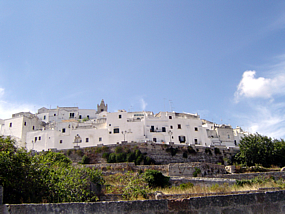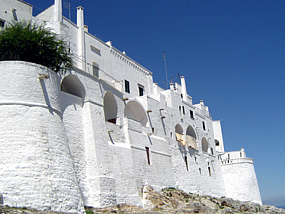Ostuni the White City
Ostuni
- Origins of Ostuni
- What to see in Ostuni
- Events in Ostuni
- Practicalities
- Seaside of Ostuni
- Masserie of Ostuni
- Trulli
- Museum of Ostuni
- Parks and protected areas
- Cuisine
- Images of Ostuni
- Ostuni local info
- Getting to Ostuni
Rentals
Services
- Property and land management
- Guest management
- Property restoration and reparing works
- Taxi service and taxi sharing service
- Services for disabled
Excursions
Food & Wine
Ostuni
Ostuni is one of the most stunning cities in southern Italy famous for the dazzling effect of its whitewashed houses. It is a genuine and charming example of Mediterranean architecture.
The city of Ostuni is a series of levels, staircases, small roads, alleys, arches. Hints of the Middle Ages are at hand in every corner, in every view to the sea, in the portal of a palace, in the walls of a convent or the front of a church.
The brightness of its whitewashed houses, set against the pink-tinged brown of its principal monument, makes the town stand out in the green of the surrounding area.
Is this happy combination of the natural and the manmade that has made Ostuni one of the most attractive cities in the region and an essential part of any tour of Italy.
Origins of Ostuni
The palaeolithic period of Ostuni
The Ostuni area was already populated during the palaeolithic period (50.000-40.000 years ago) by Neanderthal hunters who found shelter in numerous grottoes in the area.
Traces of people leaving in the area are also proved by the discovery of the body of a 20 year old pregnat woman who had been buried in a hole in a grotto 25,000 years ago. The skeleton on the young woman, now named “Delia”, is displayed in the Church of San Vito Martire inside Ostuni historic centre.
10th century BC of Ostuni

During the I century BC the Messapians inhabited the higher part of the district. During the same period the Japigi also settled here. They lived together in the territory sharing common traditions and rituals.
1st and 2nd centuries - The Roman domination of Ostuni

The name of Ostuni, from the Greek "Astu-neon" (which means “new city”), was first used after the construction of a new town over a previous one during the I and II centuries AD.
The city remained under Roman domination until the 448 AD.
After the Romans - Ostrogoths and Longobards in Ostuni

Soon after the fall of the Roman Empire it was occupied by the Ostrogoths and around the end of the VII century by the Longobards.
11th century - The Normans came to Ostuni

During the XI century the Normans came to Ostuni. In the year 1148 they built the castle which was then demolished in the XVIII century by the Duke Bartolomeo Zevallos.
Isabella D'Aragona and Bona Sforza

During the XVI century, with Isabella D'Aragona, started for Ostuni an era of culture and art. The daughter of Isabella, Bona Sforza, enlarged the surrounding wall of the city, rebuilt the Tower of Villanova and built the two towers of Torre Pozzella and Torre San Leonardo to protect the population from the attacks of the Turks.
The Zevallos period of Ostuni

In the 1679 the city was sold to the Duke of Giovanni Zevallos who with all his descendants marked a period of tyranny over the city.
The Bourbons and Ostuni in the new formed Italy

It was only after the victory against Napoleon at Waterloo when the Bourbons came to power that Ostuni sent away the Zevallos. In the 1860, when Garibaldi united Italy, Ostuni became part of the new and finally formed nation.
If you want to find out more about Ostuni buy our eBook guide

Ostuni the White City guide eBook is available for kindle, iPad, iPhone, Android, PC and Mac.
Buy it on Amazon.co.uk for just £ 3.24
Buy it on Amazon.com for just $ 5.80
What's inside
- Full coverage of the history of Ostuni with its monuments, churches and portals with reference to a map of the historic centre.
- A description of the surroundings of Ostuni: the best masserie and hypogeum mills, the prehistoric remains and cliff dwellings, the trulli houses and the coastline with reference to a map of the local area.
- The best restaurants in Ostuni and the area, the pubs, bars, lounge bars, shops and sport facilities.
- General information on transport, opening hours and the practicalities.
- Day trips: how to get to other places of interest in Puglia.
This eBook also includes four useful maps:
- - The historic centre of Ostuni;
- - The territory around Ostuni;
- - The railway network of Puglia, to help anyone who wants to move around by train;
- - A complete map of Puglia with places of historical and artistic interest.
Ostuni
Ostuni
- Origins of Ostuni
- What to see in Ostuni
- Events in Ostuni
- Practicalities
- Seaside of Ostuni
- Masserie of Ostuni
- Trulli
- Museum of Ostuni
- Parks and protected areas
- Cuisine
- Images of Ostuni
- Ostuni local info
- Getting to Ostuni
Rentals
Services
- Property and land management
- Guest management
- Property restoration and reparing works
- Taxi service and taxi sharing service
- Services for disabled
Excursions
Food & Wine







